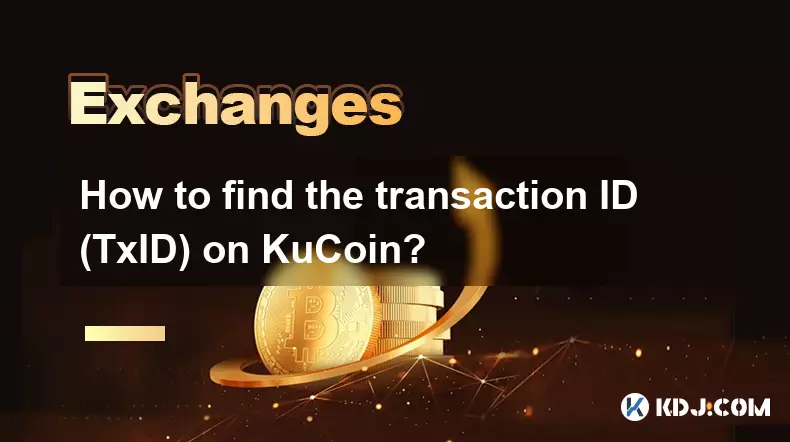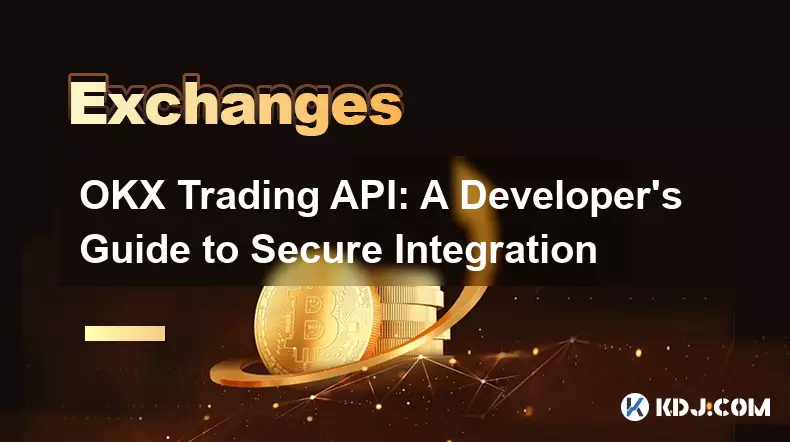-
 bitcoin
bitcoin $107015.826941 USD
-2.18% -
 ethereum
ethereum $3637.352324 USD
-5.18% -
 tether
tether $0.999831 USD
-0.02% -
 xrp
xrp $2.338078 USD
-6.23% -
 bnb
bnb $998.272150 USD
-6.97% -
 solana
solana $167.598257 USD
-10.12% -
 usd-coin
usd-coin $0.999863 USD
0.01% -
 tron
tron $0.282573 USD
-5.09% -
 dogecoin
dogecoin $0.169891 USD
-7.39% -
 cardano
cardano $0.557554 USD
-7.03% -
 hyperliquid
hyperliquid $39.914802 USD
-5.85% -
 chainlink
chainlink $15.414549 USD
-9.97% -
 bitcoin-cash
bitcoin-cash $510.361911 USD
-4.26% -
 ethena-usde
ethena-usde $0.999194 USD
-0.03% -
 stellar
stellar $0.282092 USD
-6.07%
How to find the transaction ID (TxID) on KuCoin?
A Transaction ID (TxID) is a unique, immutable identifier assigned to every blockchain transaction, essential for tracking and verifying fund transfers on platforms like KuCoin.
Oct 07, 2025 at 12:55 am

Understanding Transaction ID (TxID) in Cryptocurrency
1. A Transaction ID, commonly referred to as TxID, is a unique alphanumeric string assigned to every transaction on a blockchain network. This identifier ensures that each transfer of digital assets can be tracked and verified across decentralized ledgers. When using exchanges like KuCoin, the TxID becomes essential for confirming deposits, withdrawals, and troubleshooting issues related to fund transfers.
2. Every time a user sends or receives cryptocurrency through KuCoin, the blockchain generates a distinct TxID. This code acts as proof of the transaction’s existence and provides transparency. It allows users and support teams to trace the movement of funds from one wallet address to another, regardless of the network used—be it Bitcoin, Ethereum, Binance Smart Chain, or others.
3. The TxID is not generated by KuCoin itself but by the underlying blockchain. However, KuCoin displays this information within its interface after a transaction has been broadcasted to the network. Users must understand that once a transaction is initiated, the TxID cannot be altered, making it a reliable tool for verification and audit purposes.
4. Transactions may take varying times to confirm depending on network congestion and fees paid. During this period, the TxID remains constant. Monitoring the status via blockchain explorers using the TxID enables users to stay informed about confirmation progress without relying solely on exchange notifications.
5. In cases where a deposit does not appear in a KuCoin account despite being sent from an external wallet, providing the correct TxID to customer support helps expedite resolution. Without this identifier, verifying the transaction becomes significantly more difficult due to the volume of daily operations processed by the platform.
Locating TxID in Your KuCoin Deposit History
1. Log into your KuCoin account through the official website or mobile application. Navigate to the 'Assets' section, which displays all cryptocurrencies held in your wallet. From there, select the specific coin you wish to check—for example, BTC, ETH, or USDT.
2. After selecting the asset, click on “Deposit” and then switch to the “Deposit History” tab. Here, you will see a chronological list of all incoming transactions for that particular cryptocurrency. Each entry includes details such as amount, timestamp, status, and crucially—the Transaction ID.
3. If a deposit has been successfully recorded on the blockchain, the TxID will appear alongside other relevant data. Clicking on the TxID usually opens a new window linking directly to a blockchain explorer, allowing you to view real-time confirmation updates and network details.
4. In some instances, especially with newer deposits, the TxID might not show immediately. This delay occurs because the transaction needs at least one network confirmation before KuCoin registers it fully. Waiting a few minutes and refreshing the page often resolves this issue.
5. Always double-check the displayed TxID against the one provided by the sending wallet or exchange. Discrepancies could indicate errors in transmission or potential fraud. Ensuring consistency between both sources safeguards the integrity of your financial activity.
Finding Withdrawal TxIDs on KuCoin
1. Access the “Assets” menu and choose the cryptocurrency that was withdrawn. Click on “Withdraw” and proceed to the “Withdrawal History” section. This log contains all past outgoing transactions linked to your account.
2. Each withdrawal record shows key information including destination address, amount, fee, status, and the associated TxID. Locate the specific transaction by filtering based on date, amount, or recipient address if necessary.
3. Once identified, the TxID will be visible in the details row. Like with deposits, clicking the TxID typically redirects to a public blockchain explorer where you can monitor confirmations and validate completion.
4. For failed or pending withdrawals, the TxID may still appear even if the transaction hasn’t been confirmed yet. This is normal behavior, as the blockchain processes the request only after sufficient miner or validator validation, depending on the network protocol.
5. Keeping a personal record of important withdrawal TxIDs is advisable, particularly for large transfers. Storing them securely enables quick reference during audits, tax reporting, or disputes involving third-party services.
Common Questions About KuCoin Transaction IDs
Q: Can I find a TxID if my deposit hasn’t confirmed yet?A: Yes, once the transaction is broadcast to the blockchain, the TxID exists regardless of confirmation status. KuCoin may display it under pending deposits after a short delay. You can also retrieve it from the sending wallet’s transaction history.
Q: Is the TxID the same as the order ID on KuCoin?
A: No, they are different identifiers. The TxID refers to the blockchain transaction, while the order ID relates to trading activities within KuCoin’s internal system. Confusing these two can lead to incorrect tracking attempts.
Q: What should I do if the TxID isn't showing up in my history?
A: First, verify that the transaction actually occurred by checking the sender’s end. Then ensure you're looking at the correct cryptocurrency wallet within KuCoin. Network delays or misdirected transfers can prevent immediate visibility.
Q: Can a TxID be reused for another transaction?
A: Absolutely not. Each TxID is cryptographically unique. Reusing or duplicating a TxID would violate fundamental principles of blockchain security and immutability. Any attempt to do so would be rejected by the network.
Disclaimer:info@kdj.com
The information provided is not trading advice. kdj.com does not assume any responsibility for any investments made based on the information provided in this article. Cryptocurrencies are highly volatile and it is highly recommended that you invest with caution after thorough research!
If you believe that the content used on this website infringes your copyright, please contact us immediately (info@kdj.com) and we will delete it promptly.
- XRP, BlockDAG, and Presales: Decoding the Hottest Crypto Trends
- 2025-11-04 22:50:12
- Nature's Miracle, Super Point, and Stablecoin: A New Era for Loyalty Rewards?
- 2025-11-04 22:40:02
- ADA Slowdown, Maxi Doge, and the Meme Coin Mania: What's the Hype?
- 2025-11-04 20:50:12
- Ethereum, Crypto, and the $1 Target: A New Era?
- 2025-11-04 21:00:12
- Zone Nine: Nihilation - A Deep Dive into the Zombie Survival Closed Playtest
- 2025-11-04 21:10:12
- Trust Wallet VIP Program: TWT Powers a New Era of User Loyalty
- 2025-11-04 21:05:01
Related knowledge

Common Mistakes to Avoid on OKX: A Guide for New Traders
Nov 04,2025 at 03:37pm
Understanding the Interface Before Trading1. New traders often jump into placing orders without fully exploring the OKX platform layout. Taking time t...

OKX TradingView Integration: A Guide to Advanced Chart Analysis
Nov 02,2025 at 03:37am
OKX and TradingView: Bridging the Gap for Professional Traders1. OKX, one of the leading cryptocurrency exchanges, has integrated with TradingView to ...

OKX Perpetual Swaps: A Comprehensive Trading Strategy Guide
Nov 04,2025 at 07:05pm
Understanding OKX Perpetual Swaps Mechanics1. Perpetual swaps on OKX are derivative contracts that allow traders to speculate on cryptocurrency price ...

OKX Trading API: A Developer's Guide to Secure Integration
Nov 02,2025 at 01:01am
Understanding the OKX Trading API Infrastructure1. The OKX Trading API is built on REST and WebSocket protocols, enabling developers to access real-ti...

Advanced Security Settings on OKX: Beyond Two-Factor Authentication
Nov 04,2025 at 05:25pm
Enhanced Authentication Mechanisms on OKX1. OKX has implemented advanced authentication layers that extend beyond standard two-factor authentication (...

OKX Asset Protection Fund: How It Secures Your Crypto
Nov 02,2025 at 11:19am
Understanding the OKX Asset Protection Fund1. The OKX Asset Protection Fund is a financial reserve designed to safeguard user assets in extreme market...

Common Mistakes to Avoid on OKX: A Guide for New Traders
Nov 04,2025 at 03:37pm
Understanding the Interface Before Trading1. New traders often jump into placing orders without fully exploring the OKX platform layout. Taking time t...

OKX TradingView Integration: A Guide to Advanced Chart Analysis
Nov 02,2025 at 03:37am
OKX and TradingView: Bridging the Gap for Professional Traders1. OKX, one of the leading cryptocurrency exchanges, has integrated with TradingView to ...

OKX Perpetual Swaps: A Comprehensive Trading Strategy Guide
Nov 04,2025 at 07:05pm
Understanding OKX Perpetual Swaps Mechanics1. Perpetual swaps on OKX are derivative contracts that allow traders to speculate on cryptocurrency price ...

OKX Trading API: A Developer's Guide to Secure Integration
Nov 02,2025 at 01:01am
Understanding the OKX Trading API Infrastructure1. The OKX Trading API is built on REST and WebSocket protocols, enabling developers to access real-ti...

Advanced Security Settings on OKX: Beyond Two-Factor Authentication
Nov 04,2025 at 05:25pm
Enhanced Authentication Mechanisms on OKX1. OKX has implemented advanced authentication layers that extend beyond standard two-factor authentication (...

OKX Asset Protection Fund: How It Secures Your Crypto
Nov 02,2025 at 11:19am
Understanding the OKX Asset Protection Fund1. The OKX Asset Protection Fund is a financial reserve designed to safeguard user assets in extreme market...
See all articles










































































